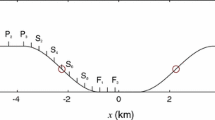Summary
The development of temperature inversion and wind structure in Colorado's Eagle Valley was investigated by means of tethered balloon ascents made during the late aftermoon and evening of 15 October 1978. Strong cooling of the valley atmosphere began after 1630 MST. The mean rate of energy loss from a 1 m-thick cross section of the valley atmosphere during the 4 h period of observations was 1.23 MW. The zone of maximum rate of energy loss propagated upwards from the valley floor after 1630 MST and was accompanied by distinctive structures in both the temperature and wind fields. Transport of cold air in the downslope flows over the sidewalls is thought to play a major role in causing the rapid growth (250 m/h) in temperature insersion depth and the strong cooling of the atmosphere in the early stages of the evening transition period.
Zusammenfassung
Die Entwicklung von Temperaturinversion und Windstruktur im Eagle Valley von Colorado wurde mittels Fesselballonaufstiegen untersucht. Diese Ballonaufstiege wurden am späten Nachmittag und Abend des 15. Oktober 1978 durchgeführt. Nach 1630 MST setzte eine starke Abkühlung der Talatmosphäre ein. Die mittlere Rate des Energieverlustes während des vierstündigen Beobachtungszeitraumes von einem 1 m starken Querschnitt der Talatmosphäre war 1.23 MW. Die Zone der maximalen Energieverlustrate breitete sich nach 1630 MST vom Talboden nach oben aus, wobei sie von charakteristischen Temperatur- und Windfeldstrukturen begleitet wurde. Man nimmt and, daß der Transport von kalter Luft in den Abhangströmungen über die Seitenwände bei der Verursachung des raschen Anwachsens (250 m/h) der Mächtigkeit der Temperaturinversion und der starken Abkühlung der Atmosphäre in den frühen Stadien der abendlichen Übergangsperiode eine bedeutende Rolle spielt.
Similar content being viewed by others
References
Defant F (1949) Zur Theorie der Hangwinde, nebst Bemerkungen zur Theorie der Berg- und Talwinde (a theory of slope winds, along with remarks on the theory of mountain winds and valley winds). Arch Met Geoph Biokl A 1: 421–450 (English transtation: Whiteman CD, Dreiseitl E (eds) (1984) Alpine meteorology — translations of classic contributions by A. Wagner, E. Ekhart and F. Defant. PNL-5141/ASCOT-84-3, Pacific Northwest Laboratory, Richland, WA 99352)
Hennemuth B (1986) Temperature field and energy budget of a small Alpine valley. Contr Atm Phys 58(4): 545–559.
Wagner A (1938) Theorie und Beobachtung der periodischen Gebirgswinde (theory and observation of periodic mountain winds). Gerlands Beitr Geophys (Leipzig) 52: 408–449 (English translation: Whiteman CD, Dreiseitl E (eds) (1984) Alpine meteorology — translations of classic contributions by A. Wagner, E. Ekhart and F. Defant. PNL-5141/ASCOT-84-3, Pacific Northwest Laboratory, Richland, WA 99352)
Whiteman CD (1982) Breakup of temperature inversions in deep mountain valley, part I: Observations. J Appl Met 21(3): 270–289
Author information
Authors and Affiliations
Additional information
With 5 Figures
Contribution no. PNL-SA-13718. A slightly modified version of a paper presented at the American Meteorological Society's Second Conference on Mountain Meteorology at Steamboat Springs, Colorado, in November 1981.
Rights and permissions
About this article
Cite this article
Whiteman, C.D. Temperature inversion buildup in Colorado's Eagle Calley. Meteorl. Atmos. Phys. 35, 220–226 (1986). https://doi.org/10.1007/BF01041814
Received:
Revised:
Issue Date:
DOI: https://doi.org/10.1007/BF01041814




